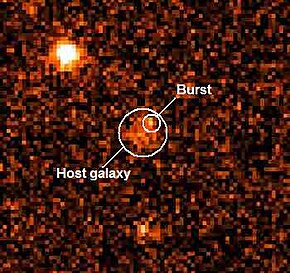
Back انفجار أشعة غاما 970228 Arabic GRB 970228 Catalan GRB 970228 Czech GRB 970228 Esperanto GRB 970228 Spanish جیآربی ۹۷۰۲۲۸ Persian GRB 970228 Finnish GRB 970228 French GRB 970228 Italian GRB 970228 Japanese
 | |
| Event type | Gamma-ray burst |
|---|---|
| Date | c. 8.123 billion years ago (detected 28 February 1997, 02:58 UTC) |
| Duration | c. 1 minute and 20 seconds |
| Instrument | Fermi Gamma-ray Space Telescope |
| Constellation | Orion |
| Right ascension | 05h 01m 46.7s |
| Declination | +11° 46′ 53.0″[1] |
| Epoch | J2000 |
| Distance | c. 8.123 billion ly |
| Redshift | 0.695 |
| Total energy output | 5.2×1044 J |
| Other designations | GRB 970228 |
| | |
GRB 970228[2] was the first gamma-ray burst (GRB) for which an afterglow was observed.[3] It was detected on 28 February 1997 at 02:58 UTC. Since 1993, physicists had predicted GRBs to be followed by a lower-energy afterglow (in wavelengths such as radio waves, x-rays, and even visible light), but until this event, GRBs had only been observed in highly luminous bursts of high-energy gamma rays (the most energetic form of electromagnetic radiation); this resulted in large positional uncertainties which left their nature very unclear.
The burst had multiple peaks in its light curve and lasted approximately 80 seconds. Peculiarities in the light curve of GRB 970228 suggested that a supernova may have occurred as well. The position of the burst coincided with a galaxy about 8.1 billion light-years[4] away (a redshift of z = 0.695), providing early evidence that GRBs occur well beyond the Milky Way; this was proven decisively two months later with a subsequent burst GRB 970508.
- ^ Cite error: The named reference
Grootwas invoked but never defined (see the help page). - ^ "GRB" indicates that the event was a gamma-ray burst, and the numbers follow a YYMMDD format corresponding to the date on which the burst occurred: 28 February 1997.
- ^ Schilling 2002, p. 101
- ^ Cite error: The named reference
nwjccwas invoked but never defined (see the help page).